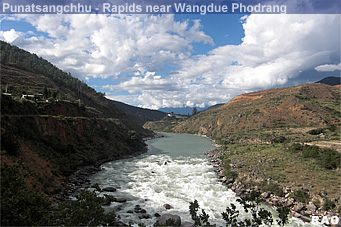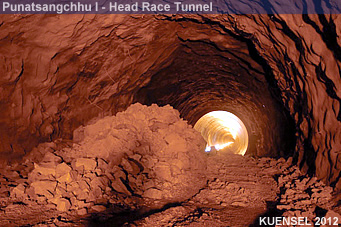| You are here: | RAO Home > Travel > Bhutan > Topics > Economy > Hydroelectric Projects > Punatsangchhu > Project | Search |
 |
| Bhutan - Economy |
| Energy |
|
 |
|
|
| Hydro Electric Projects |
| Punatsangchu I & II: Ahead of schedule |
 |
|
The construction of 1,200 MW Punatsangchu I and 1,020 MW Punatsangchu II hydroelectric projects in Wangduephodrang will be completed a few months ahead of schedule, according to project officials.
Works on desilting chambers, head race tunnel, surge shaft and pressure shafts of Punatsangchu I are ahead of schedule; and, for Punatsangchu II, not only roads and bridge construction towards the project were completed, but main works, such as construction of dam powerhouse and head race tunnel, are progressing as per schedule, managing director RN Khazanchi said.
Khazanchi said the challenge of completing both projects within the time period was well-taken, although for Punatsangchu I, to be completed by November 2016, and by December 2017 for Punatsangchu II, was tight, considering the large Punatsangchu river, as well as the geological and climatic conditions of the area.
"With the completion of the Punatsangchu I head race tunnel excavation on August 21 we aren't left with any geological uncertainty," Khazanchi said. "The first blast of Punatsangchu II head race tunnel excavation (Adit-II) on August 21 will give us an advantage of three months for the project's completion."
While Larsen & Toubro, Gammon India and Hindustan Construction company are carrying out the main civil works of constructing dam, tunnel, headrace tunnel, powerhouse and surge shaft in Punatsangchu I, only JaiPrakash Associates and Gammon India are involved in Punatsangchu II main civil works.
Initially, Punatsangchu I, located on the left bank of the Punatsangchu river, between 7 to 17km downstream of Wangdue bridge, started in November 2008, with completion to be achieved in 7 years, including 2 years of infrastructure development.
But in May 2009, the project got a setback, due to unprecedented floods.This required river diversion arrangements, which extended dam construction by a year.
"The flood was most timely, because if it had happened at a later time, we'd have suffered heavily having to rectify the ongoing construction," Khazanchi said. "Nature has been kind and we revised the generation capacity from 1095MW to 1200MW."
"The dam (concrete gravity dam, 136m high) is a very unique one, specially in the Himalayas, and everything is geared up to start concreting it with roller compacted concrete immediately after the end of monsoon season next year."
Regarding Punatsangchu II, on the right bank of Punatsangchu, between 20 to 30km downstream of Wangdue bridge, initial detailed project report was framed for 990MW, with surface powerhouse located upstream, where geological conditions were non-favourable.For an open to sky powerhouse, Khazanchi said, they have to go even below to the deepest riverbed level to find a proper foundation and below the river water level to house the turbines.
"Doing a pit like that is extremely difficult to retain the slopes on the hillside, because huge deep cuttings are involved, and stabilisation is difficult with high costs," he explained.
Going by the initial DPR, 15 million metric tonnes (MT) of mug, rock and pebbles would have to be excavated and disposed off in the project vicinity of about just 4.5 to 5MMT disposal area.
An underground power station, Khazanchi said, could solve the problem with excavation coming down to about 5MMT. "The revised DPR was approved in December 2010, with an underground powerhouse, approved by both RGoB and GoI."
Punatsangchu I has received Nu 22,861M from GoI and, as of August 1, its expenditure amounts to Nu 22,434M, with Nu 7,024M disbursed to Bhutanese agencies. The project has 931 employees, of which 757 are Bhutanese. Seven Indian and 15 Bhutanese contractors are involved. Punatsangchu I is expected to generate 5700M units of power in a year.
Punatshangchu II has received Nu 7,682M, of which Nu 4,518M had been used as on August 1, with Nu 863M disbursed to Bhutanese agencies.The project strength is 1,580 employees, of which 533 are Bhutanese. Five Indian and 12 Bhutanese contractors were involved.
| Source: Kuensel, Bhutan's National Newspaper, byPassang Norbu , August 2012 |
| Punatsangchu I: Head-race tunnel through |
 |
|
It tore down a two-metre thick rock and stone layer and marked the completion of major work on the 8.9km long head-race tunnel (HRT) that will connect the dam and the powerhouse of the project.
Of the total length, Gammon India ltd excavated 7.5km from the dam site.The remaining 1.5km from the powerhouse was done by Hindustan Construction company.The blast took place at the point, where the excavation work from the two sides meet, and opened a passage from the dam to the powerhouse.
Work at this point is known as heading, which entails cutting upper layers of the rock, project officials explained.The remaining three metres will cut towards the ground.This part of work is less risky and easier compared to heading.
The HRT was constructed through route tunnels or adits of 268m and 450m in length.Adit serves as an entry and exit to the HRT.All muck excavated from the HRT is taken out, and materials are carried in through the adits.
"The breakthrough of the tunnel means clearing all the uncertainness and risks of underground construction of the project," the managing director of Punatsangchhu projects, RN Khazanchi, said.
"Now we can start with full fledged lining of the tunnel for the smooth flow of the water."
A complete concrete lining will be built in the HRT to pass water from the dam to the powerhouse.According to the managing director, the heading work, which was achieved within the schedule of 24 months, was built at cost Nu 1,500M. It will carry about 400 cumecs of water for generating 1,200 MW of electricity.
Khazanchi said, for a Himalayan country, even tunneling of 10m was like building more than a three-storied building. "When we complete, in kilometres, it's really a great achievement," he said.
The 130m high and 230m long dam will release the Punatsangchu river through the 300m gradient HRT above the river level, and pass it through four underground tunnels to the powerhouse.
Earlier in the day, Lyonpo Khandu Wangchuk also inaugurated blasting of HRT for Punatsangchu II to mark the start of the work on phase I.The excavation work, which started from adit III, will only go up to two kilometres towards the dam.The remaining 6.6km will be completed from the dam side.The work of adit I could not be completed, because of unfavourable geological conditions, project officials said.Once completed, work on HTR will take place from three different locations.
For Punatsangchu II, the 11m in diameter and 8.6km long HTR has a water carrying capacity of about 475 cumecs to generate 1,020MW of electricity.
In case of Punatshangchu I, except the dam, scheduled for completion in November 2016, all tunneling and powerhouse work are a year ahead of schedule, according to Khazanchi.
| Source: Kuensel, Bhutan's National Newspaper, byTenzin Namgyel, August 2012 |
| Information on Bhutan |
|
|

|
|
|
|
|
|
|